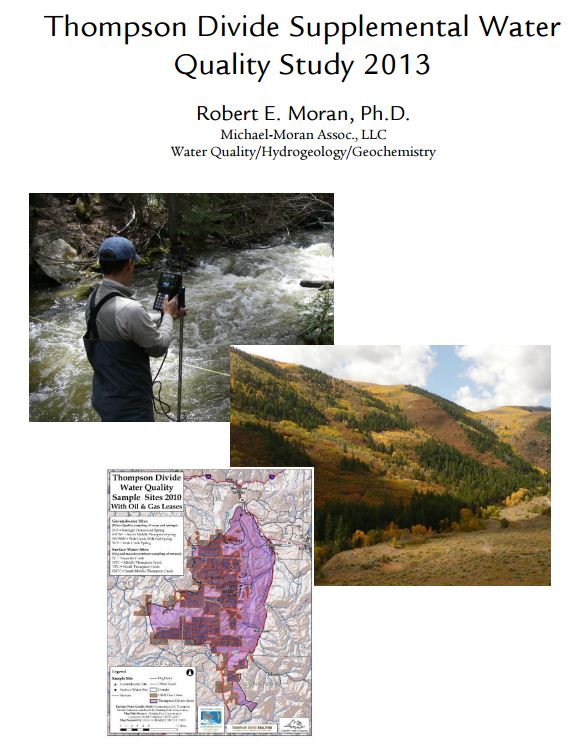This report describes the second phase (2013) of a study to define baseline water quality and flow conditions for both surface waters and springs, collected prior to the onset of any significant oil and gas development in portions of Pitkin and Garfield counties. Sampling efforts focused on the Fourmile Creek and Thompson Creek Watersheds. The first phase of this study was titled Thompson Divide Baseline Water Quality Report (Moran R., 2011).
Water quality sampling and flow measurement were conducted at four surface water and four ground water sites selected to be representative of potential impacts from proposed oil and gas drilling and development activities. The first phase activities were conducted between late September 2009 and late August 2010; the second phase was conducted between late February and early October 2013. These dates were specifically chosen to represent the range of normal, seasonal hydrologic conditions.
The list of chemical constituents reported in 2013 was reduced from those determined during 2009-10 to reduce costs. Nevertheless, it included the constituents and measurements most useful for extending the timeframe of the baseline data and for making basic hydrologic interpretations.
This second phase of the study demonstrates that surface waters at the monitored sites continue to be cold (median = 2.6C), highly oxygenated (median D.O. Saturation = 78%), largely sediment-free (visual observations), with low concentrations of dissolved chemical constituents (median lab TDS = 110 mg/L). Measurements of field specific conductance (S.C., median = 175 S) confirmed that dissolved concentrations of chemical constituents were low in all waters. This was also confirmed by the lab determinations of selected anions (i.e. ammonia, nitrate, sulfate), which were present at concentrations below reporting limits or at low concentrations. These chemical constituents were selected because they are often indicators of industrial, agricultural or human waste contamination.
No determinations of minor, trace elements, or organic compounds were included in this 2013 effort, but data for these constituents were included in the first phase, 2009-10 report (Moran R, 2011).
Ground water data show these waters to be cold (median temperature = 8.2C) and sedimentfree (visual observations), with low concentrations of dissolved chemical constituents (median TDS = 240 mg/L; median S.C. = 418 S), and moderately oxygenated (median D.O. saturation = 55%). No regulated water contaminants were detected at unacceptable concentrations in any samples.
These baseline water quality results continue to be consistent with the conclusions presented in the studies of bottom-dwelling organisms and sediment by Miller (2010). Samples collected for the present study and the Miller (2010) study were collected at the same locations. This report together with Miller (2010) indicate that the baseline waters are healthy, uncontaminated and support significant populations of benthic aquatic organisms.
Additionally, sections of the creeks sampled in this study are considered of such high quality that the Colorado State Water Quality Control Commission recently designated 3 reaches of Thompson Creek as “Outstanding Waters”.
Statistical summaries of the 2013 water quality data and Phase One 2009-2010 water quality data are presented in Appendix 1.0. A comparison of these two statistical data bases is also presented in Appendix 1.0. Compilations of all laboratory and field data are presented in a separate data file available by contacting Thompson Divide Coalition.
